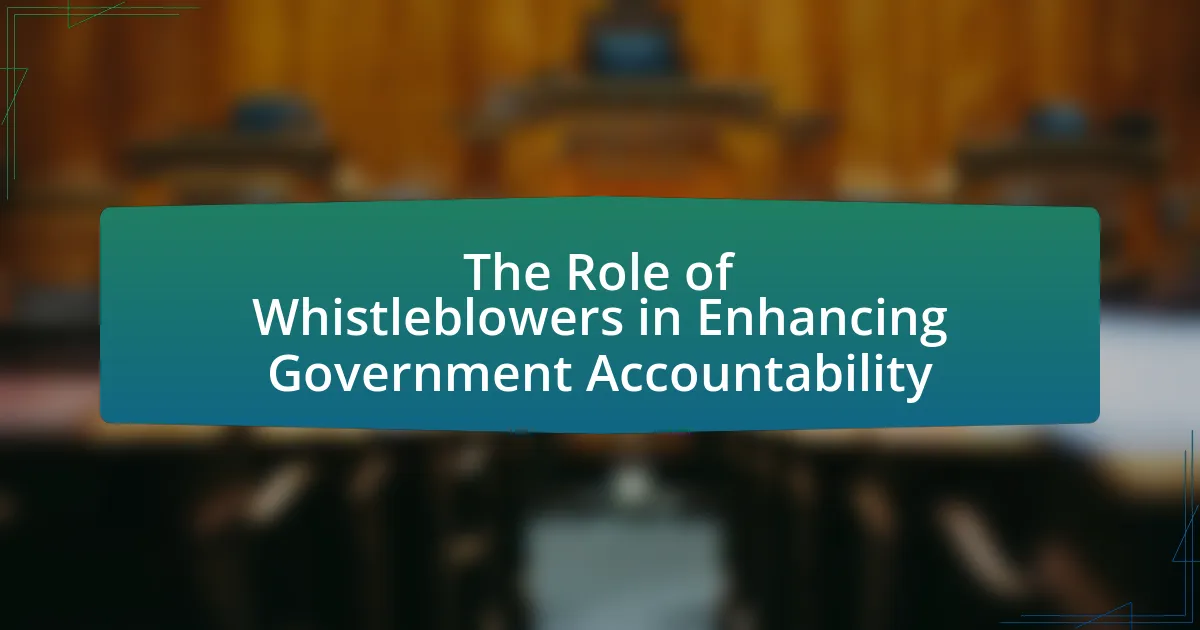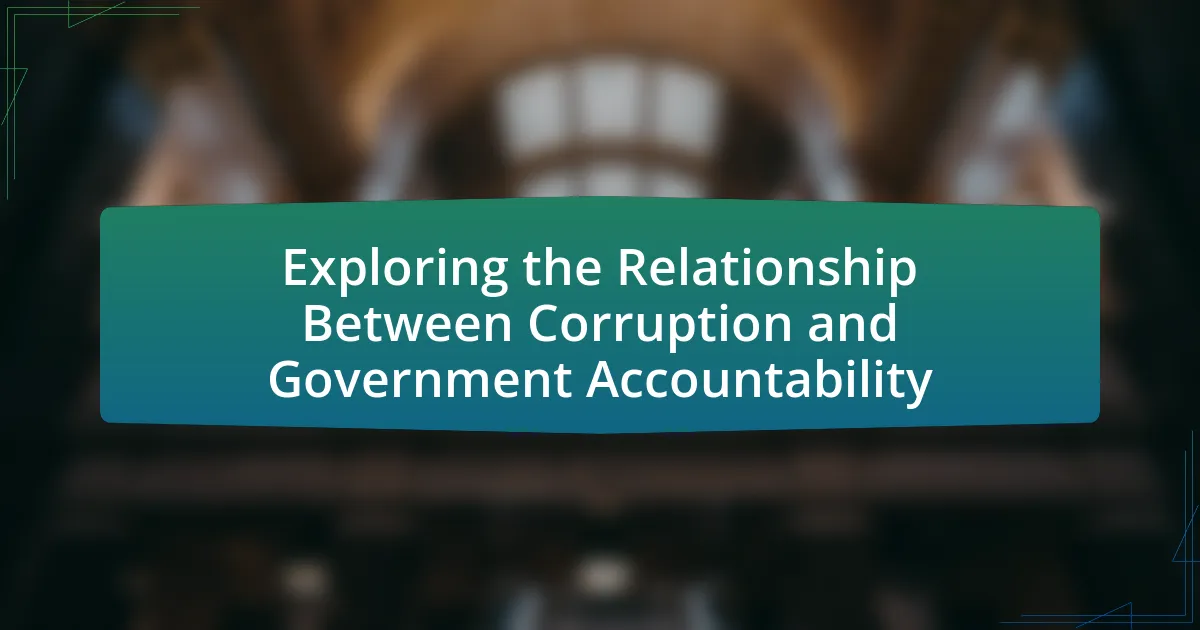The article focuses on government accountability failures, which occur when public officials neglect their responsibilities to act transparently and in the public interest, leading to issues such as corruption and mismanagement. It examines key principles of accountability, including transparency, answerability, and enforcement, and discusses notable case studies like the Flint water crisis and the Watergate scandal to illustrate the consequences of these failures. The article also highlights common causes of accountability failures, systemic issues, and the role of corruption, while emphasizing the importance of robust accountability mechanisms for effective governance and public trust. Additionally, it outlines practical steps citizens can take to enhance government accountability and prevent future failures.

What are Government Accountability Failures?
Government accountability failures occur when government entities do not fulfill their responsibilities to act transparently, responsibly, and in the public interest. These failures can manifest as corruption, mismanagement of resources, lack of oversight, or failure to adhere to laws and regulations. For instance, the Flint water crisis in Michigan exemplifies a government accountability failure, where officials neglected to ensure safe drinking water, leading to public health emergencies. Such failures undermine public trust and can result in significant social and economic consequences.
How do we define accountability in government contexts?
Accountability in government contexts is defined as the obligation of public officials to report on their actions, accept responsibility for them, and disclose the results in a transparent manner. This concept is crucial for ensuring that government entities operate effectively and ethically, as it fosters trust between the government and the public. For instance, the Government Accountability Office (GAO) emphasizes that accountability mechanisms, such as audits and performance evaluations, are essential for maintaining integrity and public confidence in government operations.
What are the key principles of government accountability?
The key principles of government accountability include transparency, answerability, and enforcement. Transparency ensures that government actions and decisions are open to public scrutiny, allowing citizens to access information about government operations. Answerability requires government officials to explain their actions and decisions to the public and be held responsible for them. Enforcement involves mechanisms that ensure compliance with laws and regulations, including oversight bodies and legal frameworks that can impose consequences for misconduct. These principles are essential for fostering trust between the government and its citizens, as evidenced by various democratic frameworks that prioritize accountability to prevent corruption and abuse of power.
Why is accountability crucial for democratic governance?
Accountability is crucial for democratic governance because it ensures that elected officials and public servants are answerable to the citizens they serve. This accountability fosters transparency, which is essential for building trust in government institutions. For instance, the Watergate scandal in the 1970s highlighted the importance of accountability when it led to significant reforms aimed at increasing oversight of government actions. Such mechanisms, including checks and balances, empower citizens to hold their leaders responsible for their decisions and actions, thereby reinforcing the principles of democracy.
What are common causes of accountability failures?
Common causes of accountability failures include lack of transparency, inadequate oversight, and insufficient consequences for misconduct. Lack of transparency hinders public scrutiny, making it difficult to hold officials accountable; for instance, in the case of the Flint water crisis, the failure to disclose water quality data led to prolonged exposure to lead. Inadequate oversight occurs when regulatory bodies lack the resources or authority to enforce compliance, as seen in various financial scandals where oversight agencies failed to act. Insufficient consequences for misconduct can create a culture of impunity, exemplified by cases where officials faced minimal repercussions for unethical behavior, undermining public trust and accountability.
How do systemic issues contribute to these failures?
Systemic issues contribute to government accountability failures by creating environments where oversight is inadequate and corruption can thrive. For instance, a lack of transparency in decision-making processes often leads to mismanagement of resources, as seen in the Flint water crisis, where systemic neglect of infrastructure resulted in public health disasters. Additionally, entrenched bureaucratic practices can hinder responsiveness to citizen concerns, exemplified by the slow governmental response to Hurricane Katrina, which showcased failures in emergency management due to systemic inefficiencies. These systemic flaws undermine trust in government institutions and perpetuate cycles of failure, as evidenced by repeated instances of misallocation of funds and ineffective policy implementation across various case studies.
What role does corruption play in government accountability failures?
Corruption significantly undermines government accountability by eroding trust in public institutions and facilitating the misuse of power. When officials engage in corrupt practices, such as bribery or embezzlement, they prioritize personal gain over public service, leading to a lack of transparency and oversight. For instance, the 2015 Petrobras scandal in Brazil revealed extensive corruption involving government officials and business executives, which resulted in billions of dollars in losses and a profound crisis of confidence in the government. This case exemplifies how corruption can create an environment where accountability mechanisms fail, as those in power manipulate systems to evade scrutiny and maintain their positions.
What are the consequences of accountability failures?
Accountability failures lead to significant negative consequences, including corruption, loss of public trust, and ineffective governance. When accountability mechanisms are weak or absent, public officials may engage in unethical behavior, resulting in misappropriation of resources and funds. For instance, the 2008 financial crisis highlighted how lack of accountability in financial institutions contributed to widespread economic instability, costing millions of jobs and trillions in lost wealth. Additionally, accountability failures can erode citizen confidence in government, leading to decreased civic engagement and increased social unrest, as seen in various protests against government corruption globally. These consequences underscore the critical need for robust accountability systems to ensure transparency and integrity in governance.
How do these failures impact public trust in government?
Failures in government accountability significantly erode public trust in government institutions. When citizens observe repeated failures, such as corruption scandals or ineffective responses to crises, they become skeptical of the government’s ability to act in the public’s best interest. For instance, a 2020 Gallup poll indicated that only 20% of Americans had a great deal of trust in the federal government, reflecting a decline linked to perceived accountability failures. This erosion of trust can lead to decreased civic engagement, lower voter turnout, and increased polarization, as citizens feel disconnected from and disillusioned with their government.
What are the economic implications of accountability failures?
Accountability failures can lead to significant economic implications, including increased corruption, inefficient resource allocation, and diminished public trust in institutions. When accountability mechanisms are weak, corruption often flourishes, resulting in the misappropriation of public funds; for instance, the World Bank estimates that corruption can reduce economic growth by up to 1.5% annually in developing countries. Additionally, inefficient resource allocation occurs as funds are diverted from essential services, leading to inadequate infrastructure and public services, which can stifle economic development. Furthermore, diminished public trust in government institutions can result in lower tax compliance and reduced investment, ultimately hindering economic growth and stability.

What are Notable Case Studies of Government Accountability Failures?
Notable case studies of government accountability failures include the Watergate scandal, the Flint water crisis, and the response to Hurricane Katrina. The Watergate scandal, which involved a break-in at the Democratic National Committee headquarters and subsequent cover-up by President Nixon’s administration, led to Nixon’s resignation in 1974, highlighting severe lapses in political accountability. The Flint water crisis, beginning in 2014, involved the contamination of drinking water due to government negligence and failure to act on known risks, resulting in public health emergencies and widespread distrust in government. The response to Hurricane Katrina in 2005 showcased failures in emergency management and accountability at multiple government levels, leading to significant loss of life and property, and revealing systemic issues in disaster preparedness and response. Each of these cases illustrates critical lessons about the importance of transparency, responsiveness, and accountability in government actions.
What lessons can be learned from the Flint Water Crisis?
The Flint Water Crisis teaches critical lessons about the importance of government accountability and public health oversight. Specifically, it highlights the necessity for transparent communication between government officials and the community regarding environmental hazards. The crisis emerged when the city switched its water source to the Flint River without adequate treatment, leading to lead contamination. This decision, made by state officials, underscores the need for rigorous regulatory frameworks to prevent such public health disasters. Furthermore, the delayed response to residents’ complaints illustrates the consequences of neglecting citizen concerns and the importance of timely action in addressing public health issues. The crisis resulted in numerous health problems for residents, emphasizing the need for proactive measures and accountability in government decision-making processes.
How did government negligence contribute to the crisis?
Government negligence significantly contributed to the crisis by failing to implement necessary regulations and oversight. For instance, inadequate monitoring of financial institutions allowed risky practices to proliferate, leading to widespread economic instability. This negligence is evidenced by the 2008 financial crisis, where the lack of regulatory frameworks permitted excessive risk-taking by banks, resulting in massive bailouts costing taxpayers over $700 billion. Such failures in government accountability highlight the critical need for effective oversight to prevent similar crises in the future.
What measures were taken post-crisis to improve accountability?
Post-crisis, governments implemented several measures to enhance accountability, including the establishment of independent oversight bodies, the introduction of stricter regulatory frameworks, and the promotion of transparency initiatives. For instance, many countries created independent commissions to investigate the causes of the crisis and hold responsible parties accountable, such as the Financial Crisis Inquiry Commission in the United States, which provided a detailed report on the financial crisis of 2007-2008. Additionally, regulatory reforms, like the Dodd-Frank Act, were enacted to increase oversight of financial institutions and prevent future failures. These actions aimed to restore public trust and ensure that government entities operate with greater accountability.
What insights can we gain from the 2008 Financial Crisis?
The 2008 Financial Crisis reveals critical insights about the importance of regulatory oversight and the risks of excessive leverage in financial institutions. The crisis was largely driven by the collapse of the housing bubble, which was fueled by subprime mortgage lending and inadequate risk assessment by banks. For instance, the Financial Crisis Inquiry Commission reported that the failure of regulators to address the growing risks in the financial system contributed significantly to the crisis. Additionally, the crisis highlighted the need for transparency in financial products, as many investors did not fully understand the complexities of mortgage-backed securities. These insights underscore the necessity for robust regulatory frameworks to prevent similar failures in the future.
What accountability failures were evident in the financial sector?
Accountability failures in the financial sector included inadequate regulatory oversight, lack of transparency, and insufficient risk management practices. For instance, during the 2008 financial crisis, major institutions like Lehman Brothers engaged in excessive risk-taking without proper accountability mechanisms, leading to their collapse. Additionally, the failure of credit rating agencies to accurately assess the risk of mortgage-backed securities contributed to the crisis, highlighting a systemic lack of accountability. These failures resulted in significant economic repercussions, including a global recession, demonstrating the critical need for robust accountability frameworks in financial governance.
How did regulatory lapses affect the crisis outcome?
Regulatory lapses significantly worsened the crisis outcome by allowing systemic risks to accumulate unchecked. For instance, inadequate oversight in financial markets led to excessive risk-taking by institutions, contributing to the 2008 financial crisis. The lack of timely intervention by regulatory bodies, such as the Securities and Exchange Commission and the Federal Reserve, allowed major financial institutions to engage in practices that ultimately resulted in widespread economic instability. This failure to enforce existing regulations and adapt to emerging risks directly correlated with the severity of the crisis, as evidenced by the collapse of major banks and the subsequent global recession.
What can we learn from the response to Hurricane Katrina?
The response to Hurricane Katrina teaches us the critical importance of effective emergency management and the need for clear communication between government agencies and the public. The Federal Emergency Management Agency (FEMA) faced significant criticism for its slow response and lack of coordination, which highlighted the necessity for improved preparedness and resource allocation in disaster-prone areas. For instance, the National Response Plan, which was in place during Katrina, proved inadequate, leading to delays in aid and support for affected communities. This situation underscores the need for comprehensive training and planning to ensure that agencies can respond swiftly and efficiently in future disasters.
What were the key failures in emergency management and response?
Key failures in emergency management and response include inadequate communication, lack of coordination among agencies, and insufficient resource allocation. For instance, during Hurricane Katrina in 2005, the Federal Emergency Management Agency (FEMA) faced criticism for its slow response and poor planning, which resulted in thousands of people being stranded without assistance. Additionally, the 2010 Haiti earthquake highlighted failures in international aid coordination, where multiple organizations operated independently, leading to duplicated efforts and wasted resources. These examples underscore the necessity for improved communication strategies, better inter-agency collaboration, and strategic resource management in emergency situations.
How has this case influenced future disaster preparedness policies?
This case has significantly influenced future disaster preparedness policies by highlighting the need for improved coordination among government agencies. The failure to effectively communicate and collaborate during the disaster response led to the implementation of integrated emergency management systems, which emphasize inter-agency cooperation and resource sharing. For instance, following the case, many jurisdictions adopted the National Incident Management System (NIMS), which provides a standardized framework for incident management across various levels of government. This shift has resulted in more efficient resource allocation and a clearer chain of command during emergencies, ultimately enhancing community resilience and response effectiveness.

How can Governments Improve Accountability Based on These Lessons?
Governments can improve accountability by implementing transparent processes and enhancing citizen engagement. For instance, adopting open data initiatives allows citizens to access government information, fostering trust and enabling public scrutiny. A study by the World Bank found that transparency in government operations can reduce corruption by up to 25%. Additionally, establishing independent oversight bodies can ensure that government actions are monitored effectively, as seen in countries like Sweden, where the Parliamentary Ombudsman plays a crucial role in holding public officials accountable. These measures, grounded in empirical evidence, demonstrate that increased transparency and citizen involvement are essential for enhancing government accountability.
What strategies can enhance government accountability?
Implementing transparency measures, such as open data initiatives and public reporting, can significantly enhance government accountability. These strategies allow citizens to access information about government operations and expenditures, fostering trust and enabling informed public participation. For instance, the U.S. government’s Data.gov platform provides access to a vast array of government data, which has been shown to improve civic engagement and oversight. Additionally, establishing independent oversight bodies, like ombudsman offices, can provide checks on government actions, ensuring that officials are held accountable for their decisions. Research indicates that countries with strong independent institutions experience lower levels of corruption and higher public trust in government.
How can transparency initiatives reduce accountability failures?
Transparency initiatives can reduce accountability failures by enhancing public oversight and fostering trust in governmental processes. When governments implement transparency measures, such as open data policies and public reporting, they enable citizens and watchdog organizations to monitor actions and decisions more effectively. For instance, a study by the World Bank found that countries with higher levels of transparency experience lower levels of corruption, as public scrutiny acts as a deterrent against misconduct. This correlation illustrates that transparency not only informs the public but also compels officials to adhere to ethical standards, thereby mitigating accountability failures.
What role does citizen engagement play in improving accountability?
Citizen engagement plays a crucial role in improving accountability by fostering transparency and enabling public scrutiny of government actions. When citizens actively participate in governance, they hold officials accountable for their decisions and actions, which can lead to more responsible and ethical behavior. For instance, studies have shown that in countries where citizen engagement is high, such as in participatory budgeting initiatives, there is a significant reduction in corruption and mismanagement of public funds. This correlation is supported by research from the World Bank, which indicates that increased citizen involvement leads to better service delivery and enhanced trust in government institutions.
What best practices can be implemented to prevent future failures?
Implementing best practices such as establishing clear accountability frameworks, enhancing transparency through regular reporting, and fostering a culture of continuous improvement can significantly prevent future failures in government accountability. Clear accountability frameworks ensure that roles and responsibilities are well-defined, which reduces ambiguity and promotes ownership of outcomes. Regular reporting enhances transparency, allowing stakeholders to monitor progress and identify issues early. Fostering a culture of continuous improvement encourages organizations to learn from past mistakes and adapt their processes accordingly. For instance, the Government Accountability Office (GAO) emphasizes the importance of these practices in its reports, highlighting that organizations that adopt structured accountability measures are more likely to achieve their objectives effectively.
How can regular audits and assessments strengthen accountability?
Regular audits and assessments strengthen accountability by providing systematic evaluations of processes and outcomes, ensuring compliance with established standards. These evaluations identify discrepancies, promote transparency, and facilitate corrective actions, thereby enhancing trust in governance. For instance, a study by the Government Accountability Office found that regular audits in federal agencies led to improved financial management and reduced instances of fraud, waste, and abuse. This evidence demonstrates that consistent oversight through audits fosters a culture of responsibility and ethical behavior within organizations.
What frameworks exist for evaluating government accountability?
Several frameworks exist for evaluating government accountability, including the Public Accountability Framework, the Good Governance Framework, and the Accountability Assessment Framework. The Public Accountability Framework emphasizes transparency, responsiveness, and the rule of law, which are essential for assessing how governments are held accountable to citizens. The Good Governance Framework incorporates principles such as participation, consensus-oriented decision-making, and equity, providing a comprehensive approach to evaluating government actions. The Accountability Assessment Framework focuses on measuring the effectiveness of accountability mechanisms, including oversight institutions and civil society engagement. These frameworks are supported by empirical studies that demonstrate their effectiveness in identifying accountability gaps and improving governance practices.
What practical steps can citizens take to hold governments accountable?
Citizens can hold governments accountable by actively participating in the democratic process, such as voting, attending town hall meetings, and engaging in public discussions. These actions empower citizens to express their opinions and influence policy decisions. For instance, the 2018 midterm elections in the United States saw a significant increase in voter turnout, with approximately 50% of eligible voters participating, reflecting a heightened public interest in government accountability. Additionally, citizens can utilize tools like petitions and social media campaigns to raise awareness about issues and demand transparency. The success of the #MeToo movement illustrates how collective citizen action can lead to significant changes in government policies and accountability measures. By leveraging these practical steps, citizens can effectively hold their governments accountable for their actions and decisions.




